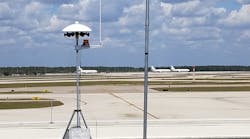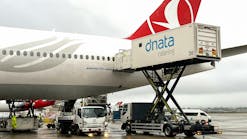Even in what is normally considered “good weather,” there can be situations hazardous to the health of outdoor workers. Intense heat can cause illness or even death. Exposure to ultraviolet (UV) radiation accompanying strong rays from the sun can cause everything from a painful sunburn to skin cancer. In lower latitudes, these risks are often present all year. In higher latitudes, they occur in the summer.
To a large extent, both excessive heat and dangerous levels of UV are a function of the intensity of sunlight, which itself is determined by the elevation angle of the sun. The higher the sun is in the sky, the less atmosphere to traverse, and the stronger the solar radiation. During a day, the maximum solar angle occurs at noon. This is typically not at “local noon” but rather “solar noon” or the half-way point between sunrise and sunset. A simple rule is that the shorter your shadow, the higher and stronger the sun is.
Over the course of a year in mid and high latitudes, the sun is at its zenith on the summer solstice. For the Northern Hemisphere, this can occur between June 20 and 22. The summer solstice for the Southern Hemisphere is the opposite, December 21 or 22. The region between 23.5oN and 23.5oS, the tropics, typically have a “high sun” throughout much of the year.
Although solar intensity and the UV threat is directly related to these astronomical events, temperature lags. It takes time for things to heat up in the summer. Highest temperatures in mid-latitudes usually don’t occur until a month after the summer solstice. In some tropical regions, the “high sun” period coincides with the rainy season. In these areas, the most intense sunlight and highest temperatures typically occur just before the rainy season starts and just after it ends. In many tropical desert locations, the highest sun coincides with the least cloudiness, thus exasperating the problem.
Looking at the heat issue first, a person’s body temperature will rise when he or she is exposed to a warmer environment or when that person is engaged in physical activity. For most outdoor workers, the combination of these factors must be allowed for. Temperatures which may be non-problematic for sedentary activities can be an issue for more strenuous work. If a body’s temperature becomes too high, it can react in different ways depending on the severity of the condition. The effects can range from heat cramps to heat exhaustion, and possibly to fatal heat stroke.
A person’s body cools itself by sweating. The water which appears on the skin will evaporate, thus giving a cooling effect. So, these situations can also lead to dehydration and a loss of electrolytes such as salt – besides an unhealthy increase in body temperature.
Interestingly, since the body cools itself by evaporating sweat, heat danger is a function of not just the temperature but also the humidity or amount of moisture in the air. Dry air would allow maximum evaporation and cooling. But humid air will slow the evaporation process and limit the self-cooling effect.
To allow for both effects with one number, meteorologists developed the Heat Index. It combines the temperature and the humidity into one value, a “feels like temperature.” For example if the temperature is 92oF and the relative humidity is 60 percent, the Heat Index would be 105oF, putting people in the “danger zone” for heat disorders. This means it would feel the same outside if the air was dry and the actual temperature was 105oF.
In the United States, the Occupational Health and Safety Administration (OSHA) has taken the lead in protecting outdoor workers with their Heat Illness Prevention campaign, launched in 2011. The key is education. To achieve the desired safety objectives, OSHA has used training sessions, outreach events, informational sessions, publications, social media messaging and media appearances. Their slogan for heat safety is “Water, Rest, Shade.” Under OSHA law, employers must protect workers from many hazards including extreme heat. To accomplish this OSHA requirements include:
- Provide workers with water, rest and shade.
- Allow new or returning workers to gradually increase workloads and take more frequent breaks as they acclimatize, or build a tolerance for working in the heat.
- Plan for emergencies and train workers on prevention.
- Monitor workers for signs of illness.
What are ground support companies actually doing to protect their workers from excessive heat?
“Our safety program makes sure everyone is aware when extreme temperatures are forecast (i.e. shift change briefings). Our local safety coordinator monitors temperatures on the ramp when they reach a danger zone,” says Vic Gregg, Director of Safety Standards and Audit, Enterprise Safety, Universal Weather and Aviation, Inc.
In terms of direct actions, he adds, “We always make sure water is available, and we try to limit direct sun exposure on employees as much as possible. When it’s more than 90oF, work in pairs. Supervisors will come out and monitor the staff. Limit outdoor time to the handling and moving of aircraft and then seek cover.”
Gregg says their hottest location would be Singapore as it is near the equator.
“At dnata, we take a holistic approach to heat health,” adds Mark Gibb, Senior Vice President, Safety and Standards, dnata. “We provide our team members with the necessities to stay safe in the heat – shaded and air conditioned rest areas and water to stay hydrated. Beyond this, we empower our people with education about heat stress – both what heat stress looks like and how to prevent it – and encourage everyone to look out for one another.”
Specifically, at their home base at Dubai International Airport, he says teams working in the heat have access to shaded and air conditioned areas, called Cool Zones.
“The dnata Cool Zones are located at key areas across Dubai International Airport and are open 24-hours a day, seven-days a week. The Cool Zones give those working in the heat a quick break to cool down, grab a drink of water, and rest,” Gibb explains.
In Dubai, where high temperatures can soar above 100oF for half the year, he notes, “dnata's heat safety precautions are in place all year long. We know that our people have to work in challenging conditions regularly, and our goal is to ensure everyone goes home safely every day.”
“We are aware that a lot of our jobs profiles involve hard work under challenging weather,” says Chistoph Meier, VP Group Communications, Swissport International Ltd. “We train our staff on how to take the necessary precautions to protect their health. Recommendations can be adapted based on local risk assessments.”
With one of their hottest sites being Riyadh, Saudi Arabia, Meier adds, “To give you some concrete examples, Swissport provides its staff not only with good advice, in addition to personal protective equipment (PPE), we also provide regular water distribution and try to accommodate more frequent breaks, when the conditions require.”
As for intense sunlight, there are two concerns. First, there are the obvious effects on temperature. Air temperatures can be 15oF warmer in the sun than in the shade. Surface temperatures of concrete or asphalt in full sunlight can be well over 100oF, perhaps close to 150oF. This will certainly increase the risk of the heat-related problems.
Also, sunlight contains UV rays. These can cause sunburn which can range from a discomforting redness to a dangerous blistering of the skin. This can even lead to skin cancer later in life. What’s more, UV rays can harm a person’s eyes and promote cataract development.
The greatest risk of UV damage comes when the sun’s rays are strongest. As mentioned, this would be the hours around noon and, for mid-latitudes, the weeks before and after the summer solstice. For tropical areas, the sun is always high in the sky and strong during the day. Elevation also plays a role in sun exposure. The higher up a person is, the less atmosphere the sun’s rays have to penetrate and the stronger they are.
Of course, cloud cover can diminish the strength of the sun’s rays. But, light or thin clouds have little effect on UV levels. And even denser clouds don’t block all UV rays. In addition, surfaces such as snow, water, sand and light colored pavement can reflect UV rays even into shaded areas.
To quantify the dangers of UV exposure, meteorologists in Canada developed the UV Index in 1992. Other countries soon followed and by 1994, the UV Index was the standard used around the world. The UV Index is a scale that runs from 0 (at night) to 16 (in the tropics at noon). Values of 6 or more bring a high risk of some skin or eye damage. Values of 11 or greater are for extreme risk situations. A maximum UV Index of 11 regularly occurs in mid-latitudes in the period near the summer solstice. Values of 12 or greater are common in the tropical regions during the high sun season.
UV Index forecasts (and additional information) are available from the Environmental Protection Agency in the United States and Environment Canada in Canada. Check with a local weather service to find this information in other countries.
For sun protection, OSHA has no general requirements for employers (unless a specific risk is proven) but recommends for workers:
- Cover up – wear loose-fitting, long-sleeved shirts and long pants.
- Use sunscreen with a sun protection factor (SPF) of at least 30, and be sure to follow application directions.
- Wear a hat – a wide brim hat, not a baseball cap, works best because it protects the neck, ears, eyes, forehead, nose and scalp.
- Wear UV-absorbent sunglasses – sunglasses don’t have to be expensive, but they should block 99 to 100 percent of UVA and UVB radiation.
- Limit exposure – UV rays are most intense between 10 a.m. and 4 p.m.
In terms of protecting workers from the direct effects of intense sunlight, of course, ground support companies have some of the same precautions used to prevent overheating.
Universal Weather and Aviation, Inc. recommends limiting exposure to direct sun.
dnata’s Gibb adds, “We provide our team members with the necessities to stay safe (including) personal protective equipment and sunscreen.”
“Swissport provides its staff not only with good advice, but with UV protection creams, hats and sunglasses,” Meier states. “Our new uniform catalog integrates UV protection sleeves and shirts, high visibility shirts, breathable closing material and high visibility vest as well as special head/neck protection.”






